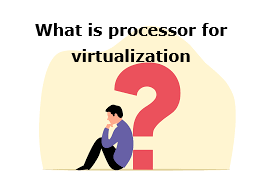In a virtual environment, you need a good processor if you want to work smoothly and efficiently. How to pick the right processor for your virtualization is the focus of this article.

Before figure out what is processor for virtualization, we need to know what is virtualization. Virtualization can be simply understood as the creation of a virtual representation of physical hardware components, and there are different types of virtualization.
A processor for virtualization is a central processing unit (CPU) designed to efficiently handle and manage a virtual environment. Virtualization is the technique of creating multiple simulated environments or dedicated resources from a single hardware system. For effective virtualization, a processor needs to support and optimize various features that enhance the performance, scalability, and management of VMs.

Knowing how to choose the best CPU for virtualizations critical for ensuring smooth performance, efficient resource management, and the ability to run multiple virtual machines simultaneously without hiccups.
Key Factors to Consider
Before diving into the specific processors, it’s essential to understand the key factors that make a CPU suitable for virtualization.
When choosing a CPU, we may be confused. As we all know, Intel, AMD and IBM, are all excellent processor suppliers, so how should we choose the best CPU for running multiple virtual machines?

When selecting the best processor for virtualization, some factors we may consider that we have already mentioned above. Although we have introduced you some popular CPUs, next we mainly compare Intel and AMD processor for different virtualization needs.
1. Core Count and Scalability
Intel
Intel’s Xeon processors are scalable and offer a range of core counts, but generally, they have fewer cores per socket compares to AMD’s EPYC processors. It also focuses on balances performance with good single-thread and multi-thread performance, but with fewer cores than AMD in comparable price range.
AMD EPYC processors typically offer higher core counts, which is advantageous in environments with many VMs. The higher core count in AMD processors allows for better scalability in virtualization environments where core density is crucial.
2. Virtualization Technology
Intel offers Intel VT-x and Intel VT-d technologies, which are hardware-assisted virtualization features that enhance the performance of virtual machines. Also, Intel’s EPT (Extended Page Tables) technology helps improve the performance of memory management in virtual environments.
AMD provides similar technologies with AMD-V (virtualization support) and AMD-Vi (I/O virtualization), which are counterparts to Intel’s VT-x and VT-d. AMD also has RVI (Rapid Virtualization Indexing), similar to Intel’s EPT, which helps in improving memory management performance in virtual environments.
3. Performance
Intel processors traditionally excel in single-threaded performance, which can be beneficial in virtualization environments. Intel has a strong presence in the server market with its Xeon processors, which are highly optimized for virtualization tasks.
AMD’s Ryzen and EPYC processors often offer more cores and threads at a given price point compared to Intel, which can be advantageous in multithreaded virtualization environments where more cores are beneficial.
Following are some detailed information for some Intel and AMD processors:
A powerful CPU ensures that the virtual machine runs efficiently. However, if your CPU has the following problems in a virtualized environment, it is urgent to perform a backup immediately to ensure data security:
AOMEI Cyber Backup is the software you urgently need. It's a free and centralized backup software for virtual machines, and it offers multiple benefits for your data protection.
Here are some features of AOMEI Cyber Backup:
Easy-to-use interface: Utilize an easy-to-navigate dashboard to set up and manage backups for virtual machines. Data protection is straightforward and can be managed with just a few simple steps, making it accessible to everyone. Automated backup: Configure a backup schedule, and backup tasks will automatically execute at the designated times. Role-based management: Use the admin account to create multiple user accounts with varying permissions for your team members. Multiple Storage Destinations: Backup VMs to local directories, network shared folders, and NAS shared folders.
Now you can click the download button to install AOMEI Cyber Backup, next are some steps to guide you on how to use this tool to back up your VMs safely and free.
Step 1. Download, install, and run AOMEI Cyber Backup on Windows or Linux computer. In its interface, click Source Device to Choose VMware. Then click +Add VMware ESXi. Then add VMs by entering the host information.
Step 2. Click Backup Task on the left pane to Create New Task. Choose VMware ESXi Backup. Then setup Task Name, Target, Archive, Schedule, and other settings based on your needs.
Step 3. Click the Start Backup to commit the backup task.
When it comes to selecting the best processor for virtualization, the right choice depends on your specific needs - whether you are running a small home lab, a mid-size business, or a large enterprise data center. AMD and Intel both offer powerful options across various price points, so you can find a processor that meets your performance requirements and budget.
By picking the right processor, you’ll ensure your virtual machines run smoothly, efficiently, and reliably.